PART 2: THE LASERING
SECTION 4
MOUNTING YOUR LED
You will need:
Hobby knife (and maybe a spare blade)
Pin vise
Drill bits ranging from 0.5mm to 1.5mm
An LED with the wires already soldered on
Coin Cell battery for testing
Super Glue (gel works best)
Green Stuff (always helpful)
Well, you’ve got your LED soldered to some wire now, and you’ve built a powered base that should, in theory, make that LED shine. But now what? Let’s cover the basic process of mounting that LED in the model.
First thing you should do, and frankly this should have been done before you even begtan the soldering and conversion process, is decide what kind of an LED effect you’re doing.
4a. LIGHTING THE HEAD
For the purposes of this section, we’re working with a single LED mounted in the head of the crisis suit to give you a wicked Laser Eyes effect.
Once you’ve decided where your LED will go, that should give you an idea of which size is more appropriate. The 1.5mm LEDs are easier to fit into the head of a suit, but you can use 3mm if it’s all you’ve got. Protip: You can bend the legs of your LEDs at pretty extreme angles. This is especially useful for mounting them in the head, because you can direct the legs downward into the neck while the light faces forward. Just make sure to test your LED with a battery afterwards to make sure you didn’t break it.
1. Be sure that you’ve soldered the wires to the LED before you put the LED in the head. This applies to all types of mountings, regardless of the parts. You don’t want to slip and melt off part of your model.
2. Take your crisis head in hand and drill straight into the center of the “face”. You don’t have to go through any of the eye lenses, because once you carve out a nice big hole the face as you know it is pretty much ruined. I have tried precision drilling through each lens, but the effect is nowhere near as impressive.
3. Start with your 0.5mm drill bit and work up to the 1.5mm bit to get a nice clean hole with a good diameter to let the light through. Don’t be afraid to go deep with your initial drilling. If your drill bit pops out of the back of the head, you can always patch the hole with green stuff later.
4. Put a pair of boxer shorts on your head. Don’t ask why. This is mission critical!
5. Clip off the big round peg that normally slots into the neck joint, giving you a flat surface on the bottom of the head. (Note: If you’re building a version of the crisis head that removes that peg, that’s cool, otherwise you can drill through it to allow the wires through and reattach the peg afterwards using green stuff)
6. Now that your crisis has a flat-bottomed head, grab your hobby knife and start hollowing it out. I like to start by spinning the point of the knife in place, then once I’ve got a hole started I proceed by cutting slices away until I’ve hollowed out the piece to my preferences.
7. After a very short while your new hole should meet up with the hole you drilled into the face. Continue carving it out until the head is almost completely hollow.
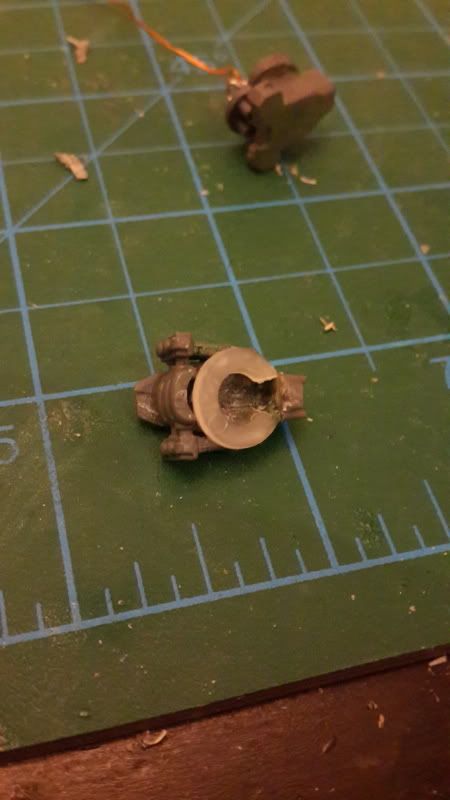
8. Test fit the LED into the hollowed out head. Do this multiple times until you have enough room to situate the light right up against the face plate. Nine times out of ten, you’ll find that you were mistaken about one dimension or another, and the LED doesn’t fit quite right. Keep hollowing it out to make enough room. This is all about trial and error, so just keep at it.
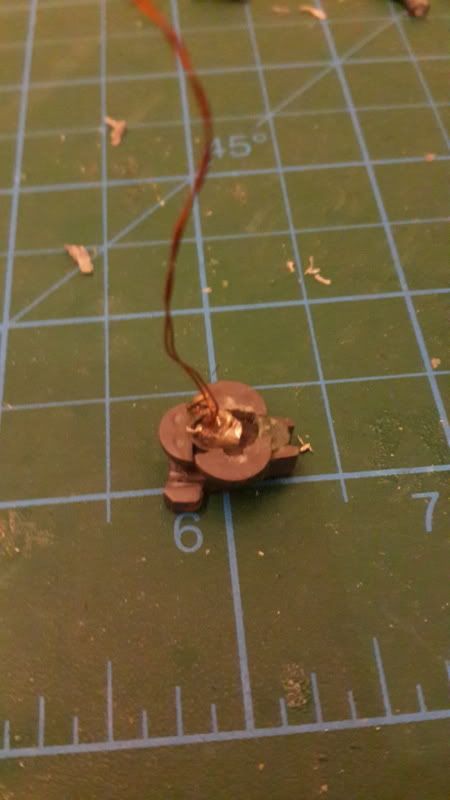
9. Once the LED fits into place and you are happy with the light you’re seeing out of the eye (you DID remember to test your LED, right?), it’s now time to attach it.
10. Keep your battery on hand for this part. Apply a fairly generous dollop of gel glue to the inside of the head. The gel’s thicker consistency fills the gaps between the LED and the rough, uneven surface inside the head. Press your LED into the desired spot, being sure to press the bulb up against the face plate for maximum light output.
11. Wait a few seconds for the glue to stick. Don’t rush this.
12. Now that the LED is seated in place and the glue is half-dried, it will hold up to you putting it down and sticking the battery between the legs to test out the LED. You want to make sure first that the LED still works, and second that the right amount of light is getting through the hole.

13. If you don’t like the positioning, the glue is still only half dried so you can adjust the LED slightly with no problem.
14. Don’t worry if glue gets on the bulb of the LED. It dries semi-clear anyway, so it won’t dull the light too much.
15. If a bunch of the gel glue got into the eye hole, you can either leave it (slightly reduced light, which is a good or bad thing depending on your preference), or you can take your pin vise and drill the hole out again after the glue has completely dried. Either way is fine.
16. Take a quick picture and put it up on your project log to brag about it and impress all the interwebs!
NOTE: If you’re building a Tael head, or any other style of head that involves gluing the target lock onto the front of the crisis head, you will want to do the following. Before you attach the target lock to the face, carve out the entire inner surface of the face and the inside of the head. Now that you have a hollowed out face, attach your target lock to the head as normal. Once you’ve attached it, take your pin vise and drill through the largest of the suit’s eye lenses, opening the hole up to about the size of the 1.5mm drill bit. This will let you put the LED right up against the target lock for an intense glow.
Wow! That was a long list, I know. Some folks out there have done enough conversion work that some of the steps will seem superfluous. That’s cool, more power to you guys, the big dogs of modding. But this guide is meant for total beginners as well, so I made sure to cut them some slack and explain everything in full detail.
So now, all the gods willing, what we have is a single LED shining triumphantly out of the Crisis suit’s eye. Awesome! Now, be absolutely sure that you carve out a big hole in the neck of the suit to let the wire down into the torso. In most head conversions, you can’t see the neck at all, so don’t worry about making it too neat. If nothing else, you can fix it with a
GS patch later on.
But what if you don’t want your LED in the head?
4b. “IRON MAN” CHEST LIGHT
You will need
Same as above, but also a circular bit, as explained below
It is okay, and I mean, perfectly permissible and encouraged, for you to put on some Black Sabbath during this part. No one will blame you.
This method is actually quite a bit simpler than putting the light in the head. Since the space you’re working with isn’t so small, you can use a larger LED for this, so a 3mm LED is just fine. Take your drill and put a hole right in the center of the suit’s chest, right in the little box in the center. You want this hole to angle slightly downward, because that light is going to be blindingly bright if you angle it up at the players, and that will not make you any friends.
1. You can drill this hole out to 1.5mm like the one in the head, or you can go up to 2mm or so. Either way, it’s gonna be bright.
2. Test fit the LED into the hole. A little bit of the LED should protrude from the chest, but not too much. Make a mental note, or failing that, take your hobby knife and scratch a mark into the surface of the LED to show where it hits.
3. Now, take the LED out and mix up a little bit of green stuff.
4. Roll a bit of
GS into a long “snake” and wrap it around the LED at the point where you made the mark. This is going to help the LED adhere to the chest-hole. That’s a technical term.
5. Apply glue to the
GS ring and plug the LED into the chest hole.
6. Allow the glue to dry some, then test the LED to make sure you didn’t break it.
7. Attach a circular bit to the chest (See Below)
Right now, you have a super bright LED shining out of the chest of your suit. It looks really cool, until you go to game with it. Then it’s obnoxious and blinding. You’ll have a splitting headache by the end of the game. To fix this, we’re going to add a baffle to the light, a round bit to blunt the knife edge that is the LED.
Choosing your round bit: You have a few options here. Any Tau modder worth his salt has probably heard of a company called Kotobukiya, whose products are available from Hobby Link Japan (
http://www.hlj.com). They sell sprues of option parts and details for Gundam models, and these are invaluable resources. One of the most useful things they sell are simply called “round mold” and it’s a sprue of tubular plastic bits. You can either grab one of those and file it down to a slight angle, or you can take the barrel of a multilaser or a lascannon and drill it out, cutting off just the very end of the muzzle to use. Either way, you want it to block a lot of the light that would normally be directed upward at the players’ faces.
(PICTURE)
Situate that round bit so that the light is directed at a slightly downward angle. You will not lose much of the brightness, but you will eliminate the headache altogether.
NOTE: The chest on the Broadside model is much thicker than the Crisis suit’s. You don’t have to add a baffle to that light. You can drill it straight into the circular portion of the Tau emblem on the suit’s chest, and the extra thickness of the chest plate will shield the excess light from the players' eyes.
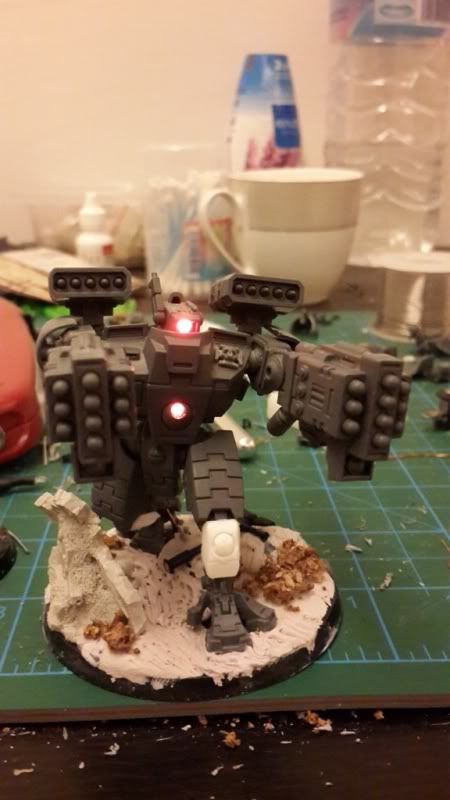
So now, what we have is a recipe for a single LED somewhere on the model. But we still don’t have power running to it from that base you built in Section 2. That’s why we’re moving on to…
SECTION 5
PUTTING IT ALL TOGETHER
You will need
The powered base you built in Section 2
Your model kit, ready to assemble
Hobby Knife
Pin Vise and Drill Bits
Soldering Iron and Solder
Green Stuff
You have a few different options of how to get the wire from your LED to the battery in your base. The way I normally do this is to carve a hole into the hip socket of the crisis suit and run it down through the leg. If you’re not concerned with appearances, you can just run the wire straight down to the base. But you are concerned with appearances, or else why would you be trying this stunt at all?
0. Make sure you have plenty of slack in your wire so that it won’t be pulled tight when you get it to the base.
1. Drill out one of the hip sockets of your suit. Either side works, but I like to put the wires on the side where the leg will be straighter (assuming you’ve cut and reposed the legs at all). This makes it easier to get the wire down through the leg.
2. Using your hobby knife, slice off the inside of the leg’s ball joint. It doesn’t have to cut off too much, you just want to make a flat surface into which you can drill easily.
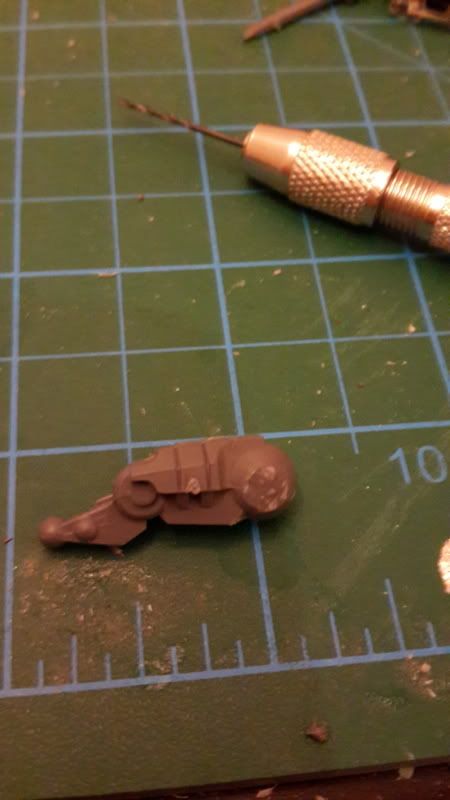
3. Start with your pin vise and drill a nice big shaft into the ball. Be careful not to come out the other side, but if you do you can always just fix it with
GS.
4. Hollow out the ball joint using your hobby knife in the same fashion as the head in Section 4a.
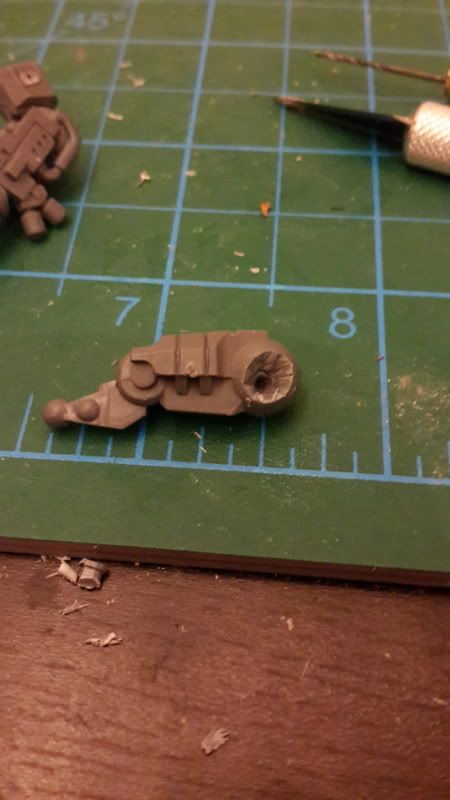
5. Flip the leg over. Using your 0.5mm drill bit, drill upward into the knee joint of the crisis suit as shown:
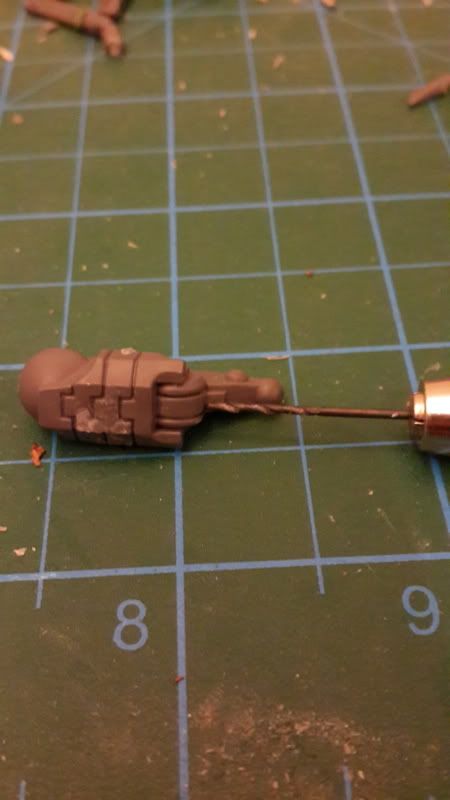
6. Continue drilling until the drill bit emerges into the hollow of the ball joint. Carve a little more of the plastic away in that area so you can get to it easily with the wire.
7. Feed the wire from your LED through the hole in the hip socket and then close up your chest. You might not want to glue it shut just yet, in case you’ve made a mistake.
8. Try to feed the wire into the narrow channel left by the drill that leads down to the knee joint. If you can’t get it in, try one of two things. First, make sure that the ends of the wire are twisted together tightly so that they take up less space and are more rigid, that should help get them in the hole. Or second, drill back up through the knee with a larger drill bit. Repeat until you get it through, then feed the wire all the way through the knee.
9. It is now safe to close the chest and attach the leg. You might need a wad of
GS for the leg joint since you carved a lot of the material out.
10. Before you glue the foot to the base, solder the wires to the battery leads sticking out of the top of the base. Be sure to put the battery in to test which lead is the correct one for each wire before soldering into place.
11. Repeat the steps of the Idiot-Proof Soldering method I described in Section 3. This time you are wrapping the wire around the battery leads. Solder each wire to the correct lead, but make sure you take the battery out when you do your soldering.
12. Seriously, not taking the battery out will screw up the whole job. The clip will become loose and wobbly and your lights won’t stay on. It’s kind of a nightmare to fix. Trust me.
13. Now that your wires are attached to the base, put the battery back in to test that it works. If it doesn’t, trace your steps backwards and figure out what went wrong, then start over from that step.
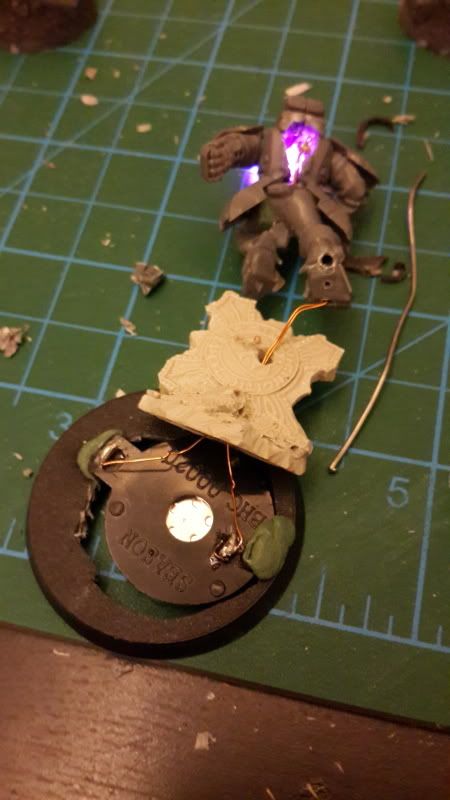
14. Once you’ve tested it successfully, you’re ready to attach the model to the base. Simply wrap any excess wire around the model’s ankle and glue the foot to the base. Attach the other leg for stability and you’re good to go.
15. Now, you’ll notice there is an unsightly wire protruding from your model’s knee, and ruining the illusion. Hide it by gluing a Fire Warrior shoulder pad or similar piece of armor over the shin. It looks better like that anyway.
16. Cover up the battery holder with your choice of basing materials. I like to start with a foundation of epoxy putty and add bits and flock to that. Regardless, you need to hide the battery holder or the illusion is ruined.
Congratulations! Your suit is now a glowing LED badass! What more could you ever want?
Oh…you do want more? You say you want multiple LEDs in your model? You want your guns to light up as well? You want multiple eyes and odd shaped heads? You even want your model to fly while glowing? Well, I suppose we could do that. Anything is possible in PART 3: REVENGE OF THE SOLDER!!!
APPENDIX
Depending on what type of model you are trying to light up, you may have a hard time getting the wire to run up the inside of the leg. The first time I ran into this problem was when I was lighting an XV25 Stealth Suit. There is no one straight line that goes all the way from foot to hip. In cases like these, you need to carefully cut at the joints and hollow out the parts so that the wire can pass up one part and into the other. Once you've passed the wire through the whole leg, use a small amount of
GS and gel glue to seal it back up. Clean up any exterior damage with your hobby knife and you're good to go. This same method works for arms, strangely shaped bodies, or any other such situation where you need the wire to go through a maze-like section of a model.
PART 3: REVENGE OF THE SOLDER
Still reading, eh? If I had to guess, and I don’t have to but I will anyway, I’d say that you’re interested in doing some more impressive stuff. Okay, we can do that. But be forewarned, once we get going and reach 88 miles per hour, it’s gonna get freaky.
SECTION 3-1: WORKING WITH MULTIPLE LEDS
You will need:
LEDs
Wire
Soldering Iron
Solder
Soldering Armature
Clippers
Hobby Knife
Coin Cell
Mountain Dew
Cheetos
Let me start by saying that, as complicated as it might seem, installing a single LED is really the easy mode of this kind of project. Now we’re getting into some rocky territory. This section isn’t going to teach you the specifics of how to wire your guns and jets and such. This is a step on the way, and I’m gonna tell you how to rig up multiple LEDs to run off one battery.
As I mentioned in a previous section, not all LEDs are exactly the same. I could get very technical, but to keep it simple just make sure to test all the LEDs you want to run beforehand. Test them together by sliding their legs down around the battery and holding them there while you slot the others on. You may notice that specific sizes or colors refuse to work with one another, or that you have two or more distinctive groups that do work together. The reason for this is called forward current value, and there’s this math formula with lots of squiggly lines involved so screw that. Just prod your way through your LEDs and figure out which ones work together. If you got all your LEDs in the same size and color, then you don’t even have to worry about this. If you’re wondering, my variety pack worked with (Blue, White, Pink) and (Yellow, Orange, Red, Green) together. But there’s a workaround that I’ll tell you about in another section. I’m such a tease, I know.
There are two ways to wire lights up together on one circuit, called Parallel and Series. For whatever reason, the more technically inclined seem to love Series configuration but I find it needlessly complicated. Parallel is how I roll, because it’s much simpler to keep track of.
Parallel means that you’re taking multiple LEDs and wiring all the negative legs together, and all the positive legs together. So, let’s assume we’re wiring up 2 LEDs for now (Chest and Eye, for example).
There are two methods I’ve used to go about this.
Method 1; The daisy chain.
This method involves wiring up an LED, then wiring another LED onto your LED like it’s one of those Xzibit memes (yo dawg). It works best when you are only connecting two LEDs to one another.
0. Complete the process of wiring a single LED as described in Part 1 (LED 1).
1. Using your coin cell, identify which leg of the LED is negative and which is positive. You may find it helpful to give one leg or the other a bend so that it is plainly marked for the future. Do the same for your second LED.
2. Connect wires to the second LED just as you did with the first, following the guide from part 1 (LED 2).
3. Take the wire attached to the negative leg of LED 2 and solder it to the negative leg of LED 1
4. Attach the positive wire to the positive leg in the same fashion.
5. Test your circuit to be sure that both LEDs light up by touching the free-hanging wires to the battery on the correct sides.
6. If both lights come on, congratulations! If not, go back and hunt down where a connection might be loose, and stick the battery between the legs of each LED to see if one might have broken. Once identified, fix the problem.
7. Mount the LEDs in the head and chest using the methods described in previous parts, but make sure you only mount one at a time or you risk making a mess of things.
8. Eat your Cheetos and Drink your mountain dew to give the glue and
GS time to set, and then mount the second LED.
9. Connect the loose wire to the powered base you built in Part 1, and you are done!
Wasn’t that easy? But what if you want to get really freaky? If you mount 3 or 4 LEDs in a single suit using the Daisy Chain method, they tend to turn into this massive sprawl of interconnected wires going this way and that, and you have to pay attention to which one you wire to which. You wind up with the right arm wired to the head, the head wired to the chest, the chest wired to the left arm, the backpack wired to the right arm…it gets jumbled. That’s why I worked out the next method.
HOWEVER, that method involves how to run wires for your guns and backpack as well. So before I explain that method, let’s tackle the big question of lighting the guns.
SECTION 3-2
WIRING YOUR GUNS
Let’s talk about how to get LEDs wired into your guns. Now, if you’ve been reading this guide and trying out some of the procedures described within, you might be looking at your guns already and thinking about ways to get them lit up. Unfortunately, the guns are not nearly as straight forward as the head and the chest. In fact, certain guns (I’m looking at you, plasma gun) are just a nightmare and you’ll see why when you actually try to wire it up. There just isn’t enough space inside these tiny guns to get the job done, most of the time.
We’re going to start off with Fusion guns and then move to Plasma guns so that you can learn how to do the job properly, or at least without ruining too many bits in the process.
DRILLING OUT AN
ARM AND PREPPNG THE SHOULDER
All attempts at wiring a gun begin with running the wire down through the arm of the crisis suit. The arms are fairly simple to drill out if you are careful. The chest can be surprisingly frustrating though, because of the way it fits together. Be patient and follow the instructions below.
0. Clip the very tip of the shoulder ball joint to make a flat surface, just as you did when drilling into the hip joint earlier in the guide.
1. Drill a hole straight through the ball joint and into the chest cavity of the crisis suit’s chest.
2. Test fit the torso together and you’ll notice that the back of the torso slots in over the place you just drilled, so carve out a portion of that surface to allow the wire to reach the arm.
3. Repeat the process for the other side.
4. Decide how your gun will be mounted (side mount or under slung, underslung is easier)
5. Cut the arm at the shoulder joint, so that the forearm and elbow are a separate piece. Clean up any rough edges from the cutting.
6. Drill a hole in the bottom of the shoulder socket so the wire can pass through it.
7. Now drill a hole up through the forearm using your 0.5mm or 1mm drill bit. The intent is to have the new hole emerge from the upper surface of the elbow joint, so line the drill up carefully when you do this step. Any mistakes can be fixed with Green Stuff later.
8. Once the hole is drilled, test fit the pieces together and adjust the holes as needed so that the wire can run straight through from the shoulder to your weapon without anyone seeing.
FUSION GUNS
You will need
Fusion blaster
1.5mm LED, pre-wired as in Part 1
Soldering Iron
Solder
Armature
Green Stuff
Hobby Knife
Coin Cell
Circular bit (see below)
1. Cut the barrel off your Fusion Gun at the joint between the thinner part and the main body of the gun. Set the barrel aside.
2. Test fit the body of the gun onto the hole you drilled in the forearm. Make a note of how much of the surface is covered up when the pieces are fitted together, because you may need to mess up one piece or the other to make the wires fit properly.
3. Start by drilling straight into the body of the gun with your 1mm drill bit from the side you just cut. Drill in as far as the attachment point where you want the wire to come in.
4. Once that hole is drilled, flip the bit around and drill a hole into the body of the gun where you want the wire to enter, pointing towards the barrel. This should quickly meet up with the hole you drilled from the other direction.
5. Once the two holes meet up, hollow the area out a bit more with your hobby knife but remember to leave enough surface for the barrel to reattach securely later on.
6. Test fit the pieces together and feed the wire through to make sure it goes in easily without kinking up or getting stuck.
7. Now set the body aside and pick up the barrel. Shave off the nozzles at the end so that the face of the gun is flat. Now take your 1mm drill bit and drill a hole in the center of the barrel that runs all the way through to the other side. This will require patience on your part and you may find it easier to go in from the other side as well.
8. Widen that hole using your 1.5mm drill bit, being careful not to rupture the sides of the gun.
9. 1.5mm LEDs are actually about 3mm wide at the base, so you will need to use your hobby knife to completely hollow out the end of the barrel, leaving just enough of the walls to keep the piece sturdy.
10. Using your flush cutters or hobby knife, trim down the rectangular base of the 1.5mm LED so that it will fit into the hole you have prepared. Make sure that the legs have plenty of room and will not be forced to tough together when pushed down the barrel. Test fit and trim more until you are able to seat the LED all the way into the inside of the barrel.
11. Solder the LED to two long pieces of wire if you have not already done so. These will need to be long enough to go up the gun, through the arm and the shoulder, into the chest, and connect to your power circuit there.
12. Feed the wire all the way through all of these parts one at a time and seat your LED into the gun barrel with a bit of gel superglue. Once it’s in place and you’ve tested to make sure it still functions, go ahead and glue the gun to the arm, then the arm to the shoulder.
13. Feed the wire into the chest and solder it to the circuit there before you glue the arm or chest into place.
14. Fit a circular bit over the LED to act as the new nozzle for the gun, and to blunt the extreme light these LEDs will put out. I used some lens bits from Bandai that were made for Gundam kits, but you could use the barrel of a lascannon, multilaser or anything else you feel is appropriate. Fill the edges around it in with green stuff.
15. Smooth out any rough edges along the gun and fill any gaps with green stuff.
16. Repeat these steps for the other side if you are running a second Fusion gun.
Now, barring any catastrophic fail, you should have a crisis battlesuit with 4 glowing LEDs. One in the Chest, one in the head and one or two in your fusion guns.
PLASMA GUNS
Plasma guns gave me a very hard time when I first set out to light my crisis suits. When you attempt to tackle the problem yourself and really get into the nuts and bolts, you’ll understand. The Tau plasma gun is just a little too skinny to make this an easy task. Luckily, the plasma guns from the Broadside kit are significantly thicker than their crisis cousins. You’ll want to use those for lighting with LEDs.
Step one is obviously to acquire the guns, either from a bits seller or from a spare kit lying around. Then you’ll need to do the whole routine of making sure that all your LED colors are compatible, as I mentioned before, and that they all work. Once you’ve got that done and you’ve got the LEDs wired up individually, it’s time to get to work on your plasma gun.
Important note: You will want to clip the legs on the LEDs VERY short for this application, so short that they’ll be tougher to work with. The reason is that you don’t have much room for them in the body of the gun, and this will save you some serious headaches.
You will need:
Broadside Plasma Gun
Wired 3mm LEDs, legs cut very short
Hobby Knife
Green Stuff
Clippers
Pin Vise and drill bits up to 3mm in size
1. Separate the plasma barrel from the gun’s body. Carve away the thin section that normally connects the two.
2. Starting from the tip, drill into the plasma barrel using your 1mm drill bit. You may want to start the hole with your hobby knife. Drill completely through to the other side.
3. Starting from the flat side of the barrel, drill into it with your 1.5mm drill bit, about half way. Widen the hole using your 3mm drill bit, being VERY careful not to damage the bit. The barrel should be almost completely hollow by now.
4. Test fit your 3mm LED. You should notice that the entire bulb of the LED fits snugly inside the barrel now, with the exception of the flanged base (if applicable, some LEDs do not have the wider base).
5. You have two options at this point and it depends on your preferences. You can either leave it as-is and leave the base of the LED exposed, which will result in a bright ring of light at the base of your barrel as well, or you can conceal the entire LED inside.
6. If you choose to conceal the whole LED, carefully cut away most of the flanged base with your clippers and hobby knife. Do this gradually to avoid breakage.
7. Test fit again, and then hollow out the barrel very carefully with your hobby knife, being sure to remove only small slices at a time until the LED finally fits into the barrel entirely, leaving just the wires and legs sticking out. Test the LED with the battery, just in case.
8. Set the barrel aside and pick up the body of the gun. Clip away the peg that will attach the gun to the arm.
9. Starting from the front face where the barrel will attach, drill into the body of the gun with your 1mm bit, then hollow out the gun as much as possible with your knife and drill. You will need to remove a great deal of the face to which the barrel will attach, so that the legs of the LED can slot into the gun neatly.
10. Drill into the spot where the attachment peg used to be to allow your wires to go through the gun.
11. Test fit the barrel onto the gun. If the legs of the LED met resistance, hollow out the body some more and try again. Remember that at this stage you can spin the LED around within the barrel to change the orientation of the legs.
12. Once the Barrel assembly fits flush against the body of the gun, roll out a very skinny “snake” of green stuff.
13. Secure the LED in the barrel with a small amount of gel superglue, and remember to test-fit it again before the glue sets in case you need to make last minute adjustments. Test the LED with the battery to make sure it still works.
14. Eat your Cheetos and drink your Mountain Dew so that the glue has time to set.
15. Add a small amount of glue to the perimeter of the barrel. Run that skinny green stuff “snake” around the edge so that it will adhere easily to the body of the gun, then put a tiny bit of glue onto that.
16. Feed the wire through the body of the gun, and then seat the barrel flush against the body of the gun. Use the flexibility of the
GS to very slightly adjust the barrel’s position, until you’re satisfied that it’s pointing straight in the direction you want it.
17. Touch the wires to your battery to give the LED a final test.
18. Do NOT go in with your hobby knife and try to remove the excess
GS. Do NOT try to patch the hole around your barrel assembly right now. The
GS is too soft and you have it just how you want it.
19. Set it down and walk away. Let the green stuff cure.
20. I mean it. Come back tomorrow.
21. Sleep.
22. Is it the next day? The green stuff around the barrel is now cured. NOW you can go in with more
GS and fill in all the holes you made and repair the visibly scarred parts of the gun. NOW you can use your hobby knife to remove any excess
GS from the barrel’s attachment point.
23. Run the wire up the arm and into the suit just as in the previous example.
OPTIONAL: Fiber Optics and Necron Rods.
You might not be satisfied with the light coming from deep inside the gun. You might want the light to shine right out the tip of the barrel. Okay, we can work with that. You have two options for this.
1. Fiber Optics. Stick a 1mm string of Fiber Optic wire down the barrel until it touches the LED. Glue it in place (very little glue) and then clip it off at the desired length. You can either clip it off flush with the barrel or you can leave 1 or 2mm sticking out. If you leave some sticking out, you can touch the tip of your soldering iron to the tip of the optical wire, and it will do this cool mushroom effect (experiment before you actually try this on the model, to get a feel for it). The result will be a wider-shining light, and the mushroom head will contract down against the barrel. Hard to explain, hard to photograph, but if you experiment with this you’ll see exactly what I mean in person.
2. You can widen the hole in your barrel to 2mm and then shove a green necron rod down the hole, all the way til it touches the LED. Clip the rod so that it is flush with the barrel, and the LED light will be shining brightly out the tip. If you have a white LED, this will tint the light green. Other colors are almost completely unaffected.
APPENDIX:
With all the talk about saving space and how tiny the plasma gun is, you might be asking why I didn’t use the 1.5mm LED. The problem is that the barrel is quite long. The base of the 1.5mm LEDs is rectangular, and you wind up trying to put a square peg in a round hole. It never quite sat the way I wanted when I tried it, and the light was always cocked to the side, resulting in a dim glow from the barrel instead of a bright light. You can try it with a 1.5mm LED, and by all means show me how yours comes out if it works for you, but I found that the 3mm round ones fit very neatly in the barrel.
HYDRA WIRING
Now that we got through the basics of how you’ll want to wire your guns, I feel I should tell you about the other wiring method I managed to figure out. Personally, don’t like it as much but it can be useful if you’re working with a lot of LEDs.
Wiring Method 2; The hydra.
This method is more complicated and can be a bit of a headache, so just be forewarned of that. I find this method works better when I have to manage a lot of LEDs in a suit.
1. Cut off four lengths of wire (or however many LEDs you have) and strip one end of each of them.
2. Cut off a fifth wire that will connect the rest to your base and strip one end.
3. Twist the stripped ends of the four LED wires together very tightly, so that they stay together securely.
4. Wrap the stripped end of the base wire around this twisted cluster.
5. Solder the entire cluster generously so that all the strands are permanently connected.
6. These wires will all go to the positive legs of all your LEDs, while the one lone wire snakes down to the positive end of your battery holder.
7. Repeat the process a second time, so that you have a second wire cluster to connect to all the negative legs of your LEDs, and the negative lead on your battery holder.
This can be very useful for wiring up a tank or the like, where all your LEDs are in one big compartment. It would also work well if you had a lot of LEDs in one part of the model and needed to connect them all to the circuit with one wire. Personally, it’s a bit of a hassle for crisis suits since you have to solder your LEDs after you’ve run the wire through the model. However, for completion’s sake I felt I should include this method so that you aren’t left wondering.
Automatically Appended Next Post: Still to come: Additional effects, glowing fuel rods and muzzle flashes, more total insanity.